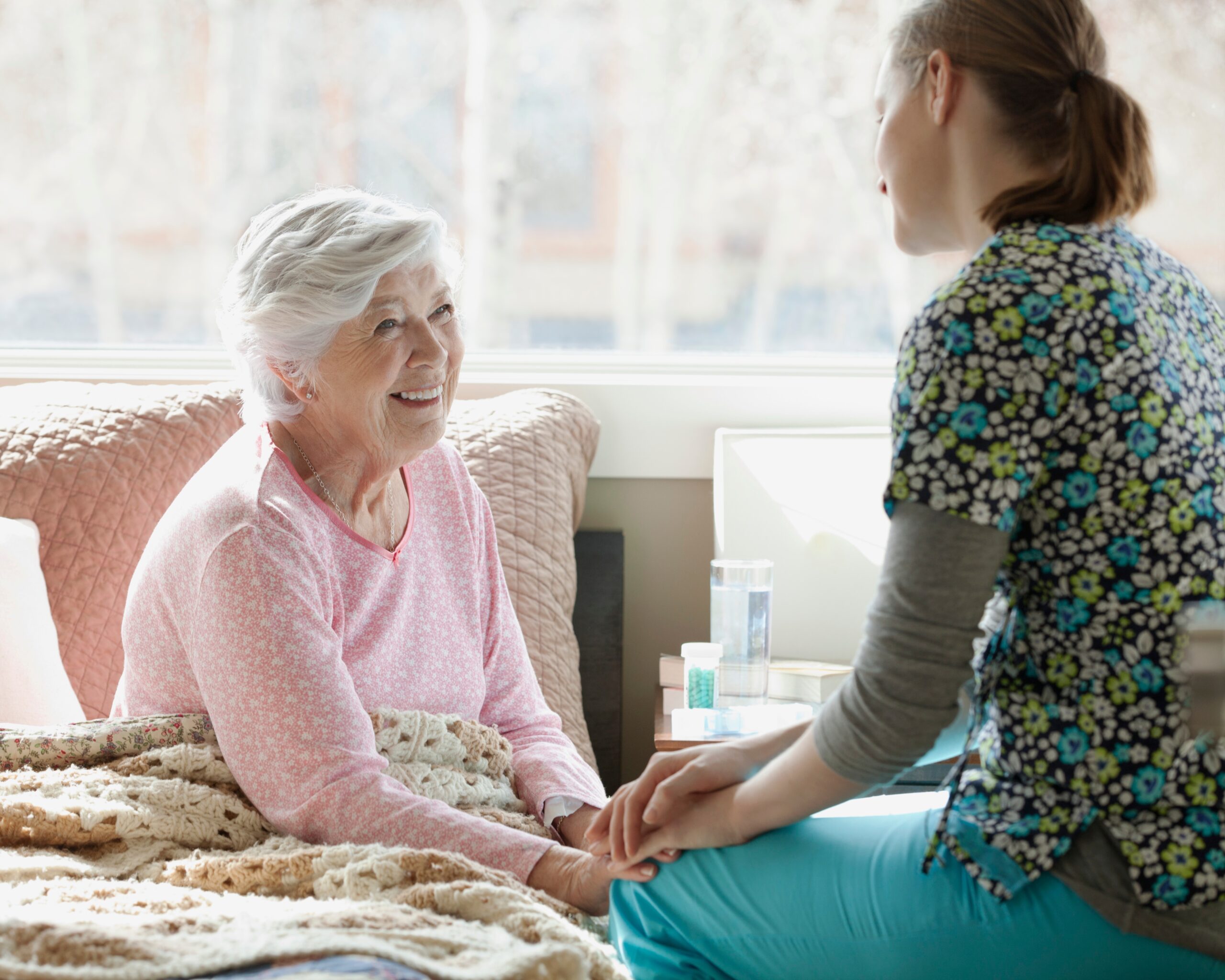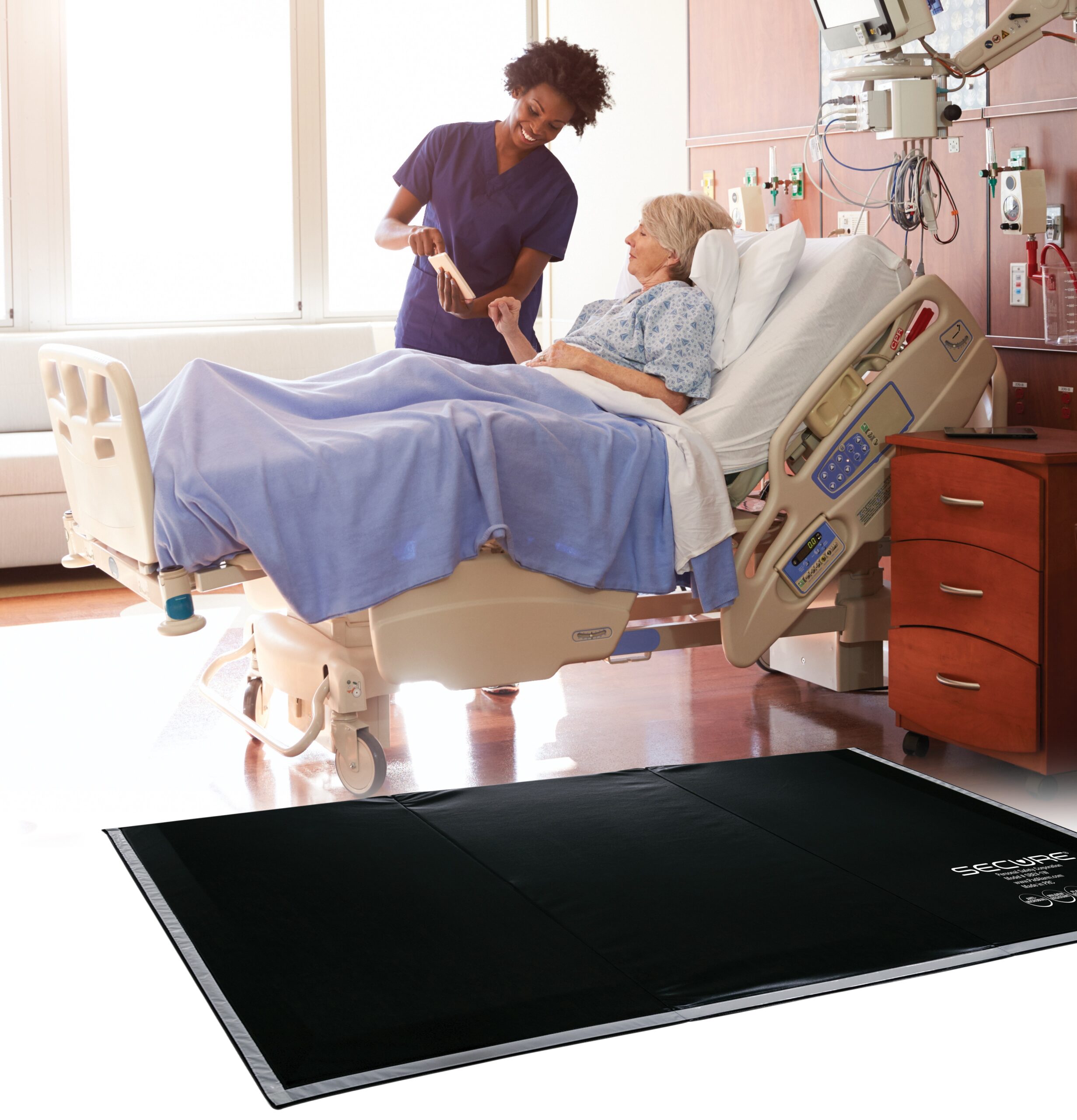Key Takeaways
- Comfortable, high-quality sleep is essential for reducing the risk of several health issues, including obesity, type 2 diabetes, high blood pressure, heart disease, and even early death.
- Older adults, especially those living with chronic diseases, are at a higher risk for circulation issues, which can hurt both your quality and quantity of sleep.
- Those who spend a lot of time in bed or experience incontinence are at a higher risk of developing pressure ulcers and dermatitis.
- Older adults are 3.5 times more likely to die in fires than the general population.
Your bedroom is likely a sanctuary for rest and relaxation, but it can also pose unexpected hazards for older adults. From falls risks to circulation issues, older adults face unique challenges. We’re committed to empowering you with steps you can take to make your bedroom a secure and more comfortable space. The ultimate goal is to ensure you have a safe place to relax and get a good night’s sleep.
Why bedroom safety?
Home safety is of utmost importance to your overall health and wellness, and the bedroom is one of the most significant locations when it comes to safety. Awareness and proactive measures can help prevent potential accidents since the bedroom can harbor risks that disproportionately affect older adults, including:
- Bed falls: Falls from the bed may occur during sleep or while getting out of bed. The risk escalates for those with mobility challenges or those taking medications that impair balance.
- Room falls: Reduced mobility or vision, clutter, poor lighting, and loose rugs can increase the risk of falls in the bedroom.
- Circulation issues: Poor circulation isn’t just uncomfortable, it’s a health risk. Extended periods in the same position in bed can lead to issues like blood clots, swelling, and pressure ulcers (bed sores).
- Bedding hygiene risks: Clean bedding is crucial, especially for those who spend extended periods in bed or experience incontinence. Neglected hygiene can lead to skin infections and respiratory issues.
- Fire: The risk of fire can be reduced with minor home renovations. A bedroom evacuation plan is also important, especially if mobility is limited.
Safety, comfort, and sleep quality
Quality sleep is essential for overall well-being. Older adults often face sleep challenges, such as difficulty falling and staying asleep. A safe bedroom contributes to better sleep by reducing stress and physical discomfort.
According to the Centers for Disease Control and Prevention (CDC), quality sleep reduces the risk of obesity, type 2 diabetes, high blood pressure, and even early death. By focusing on bedroom safety and comfort, you’re not just avoiding immediate hazards—you’re fostering an environment that supports quality sleep, which positively impacts your overall quality of life.
Bed falls
About 25% of adults over age 65 experience a fall each year, some of which occur in the bedroom. These can be trip falls or falls out of bed.
Falling out of bed is a significant concern for older adults, as it can lead to severe injuries and a decline in overall quality of life. Of special concern is the possibility of a long lieⓘ , where the person may lie on the floor for prolonged periods of time, unable to rise on their own. Understanding why bed falls happen and using strategies to reduce the risk are crucial steps in creating a safer bedroom environment.
Why do bed falls happen?
Falling out of bed may be due to circumstances involving someone’s health (intrinsic factors) or issues with the bed or room itself (extrinsic factors). More specifically, bed falls may be caused by:
- Mobility issues: Reduced strength and balance can make it challenging to get in and out of bed safely. An older adult may have mobility issues due to a chronic condition, like arthritis or vertigo, a recent surgery, or a medical event, like a stroke. People with dementia may experience sundowning, or agitation and confusion, that starts in the late afternoon and often progressively worsens as the day transitions to night. This agitation and confusion can also increase the risk of falls for people with dementia.
Christopher Norman, a geriatric nurse practitioner based in New York state who reviewed this article, added: “You know people often get shorter as we age? As the spaces between the vertebrae (back bones) get thinner, the spine may compress, which exaggerates the curve of the spine. This shifts the center of gravity forward even when a person is standing ‘straight up.’ This center of gravity shift is another risk factor for falling that many older people contend with.”
- Medication side effects: Certain medications can cause dizziness or imbalance, increasing the risk of falls. The most commonly associated medications are benzodiazepines like Xanax or Valium (for anxiety or sleep difficulties), antidepressants like Zoloft, Paxil, Lexapro or Prozac, and medications that have anticholinergic effectsⓘ , such as sleeping aids and antihistamines.
- Vision impairment and poor lighting: The combination of reduced vision and a dark bedroom makes it very difficult to navigate getting in and out of bed. Glasses can be hard to locate once taken off for the night.
- Sleep disorders: Conditions like sleepwalking, REM sleep behavior disorder, and restless leg syndrome can lead to unintentional movements that result in falls. Also, incontinence can lead to excessive waking and attempts to get in and out of bed. Rushing to the bathroom due to a sense of urgency contributes to falls the most.
“We also naturally diurese at night, which adds to the issue of needing to use the bathroom more frequently,” said Norman. “When people have leg swelling due to poor circulation, for example, we tell them to ‘put their legs up’ like being in bed so that fluid that’s leaked out of blood vessels and into the surrounding tissue, has a chance to move from the tissues back into the blood vessels and circulatory system. Once this extra fluid is back on the circulatory highway, it can be filtered in the usual fashion and excreted or urinated out.”
- Improper bed height and clutter: Beds that are too high, too low, or surrounded by clutter can make it difficult to get in and out of bed safely. Slippery bedding can also be a risk.
Strategies for reducing bed falls risk
While intrinsic factors can be difficult to remove, extrinsic factors may be altered in several ways in order to make the bed safer. These steps can help reduce the risk of bed falls:
- Replace the mattress: Make sure the mattress is comfortable and firm. A soft, saggy mattress is very difficult to rise from.
- Make adjustments to the bed: Placing the bed next to a wall will keep you from falling off on one side. Lowering the height of the bed reduces the risk of falling and also the risk of injury if you do fall. The ideal bed height is dependent on a number of factors, but a mattress height of 18–23 inches is considered safe for most older adults. Using an adjustable base bed can help you to rise from the bed more easily.
- Support: Installing bed rails and keeping assistive devices like walkers close by can provide the necessary support for getting in and out of bed safely. Transfer poles can also be installed next to a bed and are considered safer than bed rails. Because these poles are considered durable medical equipment, Medicare Part B may cover them.
- Barriers: Strategic placement of pillows or foam bumpers can help keep you from rolling off the bed.
- Bed alarms: Bed and chair alarms can alert you or a caregiver if you are about to fall out of bed.
- Non-slip footwear and mats: If you have a slippery floor, wearing non-slip socks or slippers can provide additional grip. Non-slip mats can be installed for extra safety and should be secured to the floor with double-stick tape.
“Slippers that can wrap around the heel are better than slip-on slippers,” said geriatric nurse practitioner Norman. “Slip-on slippers often cause people to shuffle to keep the slippers on their feet. Older people, for a variety of reasons, are prone to shuffle already, and this lack of picking up the feet enough when walking contributes to fall risks.”
- Fall mats: Cushioned fall protection mats placed where a fall is likely to occur will reduce the risk of injury. Be careful that the mat itself does not provide a trip hazard, though.
- Reduce hazards from around bed: Securing cords and removing clutter from the floor around the bed will reduce the risk of tripping.
- Under-bed lighting: Illuminating the floor around the base of the bed will reduce risks associated with difficulty seeing in a dark room. Some adjustable base beds come with under-bed lighting, but it can easily be added to any bed with room underneath. Motion sensor lights that plug into outlets or lights that come on after dark are also beneficial.
Bed falls in clinical settings
In clinical settings, like skilled nursing or assisted living facilities, the risk factors for bed falls can be similar but are often worsened by unfamiliar surroundings and varying levels of staff attention. It’s crucial for older adults and their caregivers to coordinate with health care providers and staff to implement safety measures. In addition to the strategies mentioned above, we recommend:
- Personalized falls risk assessment: Ensure the facility conducts a thorough falls risk assessment and incorporates the findings into the care plan.
- Regular check-ins: Request that staff check on the person at regular intervals, especially at nighttime.
- Communication: Keep an open line of communication with the health care team to discuss any concerns or adjustments needed in the care plan.
Room falls
Bedroom safety isn’t just about the bed, but the entire room. While bed falls are a significant concern, room falls—those trip-and-fall accidents that happen around the bedroom—are equally important to prevent. These types of falls can result from various factors, such as poor lighting, clutter, and even the lack of supportive features like handrails. Here are some strategies to lower the risk of tripping and falling in your room:
- Mobility aids with friction device: These specialized walking aids provide better grip and stability on bedroom floors.
- Night lights: Placing night lights along the path to the bathroom or closet can prevent falls resulting from impaired vision.
- Motion sensor lights: These lights turn on automatically when movement is detected, providing instant illumination.
- Handrails: Installing handrails along the walls can offer additional support while moving around the room.
- Furniture arrangement: Ensure that furniture is arranged in a way that allows for clear walking paths.
- Securing your pathway: Remove or secure loose rugs to the ground to prevent tripping hazards.
- Regular inspections: Periodically check the room for potential hazards like loose floorboards or protruding nails.
- Consult a professional: A professional home safety evaluation can provide personalized recommendations.
- Install voice-activated devices: Amazon Echo or Google Home devices can control electronics and lights in the bedroom with simple voice commands.
- Wear a fall detection device: These devices will notify caregivers or call emergency services if you do have a fall.
Bedroom clutter and falls
Clutter can be more than just an eyesore. It’s a genuine safety hazard. Many older adults hold onto clutter for sentimental reasons or because they’ve lived in the same home for many years. While the emotional attachment to items is understandable, it’s crucial to recognize clutter significantly increases the risk of falls. Because decluttering can often be emotionally challenging, it’s important to ease into it gently.
Easing into decluttering
- Start small: Begin with a single drawer or corner of the room. The sense of accomplishment from small wins can make the overall task less daunting.
- Involve others: Sometimes the emotional aspect of decluttering is easier to handle when you’re not doing it alone. Invite family or friends to help and offer emotional support. Norman added, “Gifting treasured items is also often easier than throwing things away, and identifying people to give things to contributes to mutual good feelings.”
- Set emotional boundaries: Before starting, decide what types of items you’re willing to part with and which ones are non-negotiable. This can make the process less emotionally taxing.
- Take photos: For items that are hard to part with, consider taking photos as keepsakes. This allows you to preserve the memory without keeping the physical item.
- Consult a professional: If decluttering feels overwhelming, consider hiring a professional organizer who specializes in working with older adults. They can provide a structured approach and emotional support.
Circulation issues
Circulation issues can be a significant concern for older adults, particularly when it comes to getting a good night’s sleep. Poor circulation can impact both the quality and the quantity of sleep. It can also lead to discomfort, numbness, and pain, making it challenging to find a comfortable sleeping position. In some cases, older adults may find relief only in specific sleep positions or with their feet hanging off the end of the bed, which may pose a safety hazard for falls or other injuries. Improving circulation can alleviate these issues and contribute to a safer, more comfortable sleep environment.
Who is at risk for circulation issues?
Circulatory problems and heart disease go hand-in-hand since your heart is in charge of circulating your blood. Risk factors for heart disease are:
- High blood pressure (hypertension): High blood pressure can lead to poor circulation by damaging the lining of the arteries.
- High cholesterol: Plaque buildup in the arteries restricts blood flow. Diabetes: Diabetes damages blood vessels in the fingers, toes, brain, and heart.
- Obesity: Excess weight puts strain on the heart and circulatory system.
- Smoking: Smoking narrows the blood vessels.
- Diet: Eating a diet high in saturated fat and cholesterol can contribute to heart disease.
- Sedentary lifestyle: Lack of physical activity can contribute to poor circulation.
Strategies for addressing bedtime circulation issues
There are many strategies aimed at reducing circulation problems:
- Foot elevation: Using an adjustable base bed can help you find a more comfortable sleeping position that elevates the legs to promote better circulation. This can also be accomplished with pillows under the feet.
- Regular exercise: Engaging in regular physical activity, especially cardiovascular exercises, can improve overall circulation. According to the CDC, adults age 65 and older should aim for 150 minutes a week (30 minutes a day, five days a week) of moderate-intensity activity like brisk walking or 75 minutes a week of vigorous activity, like hiking, jogging, or running. The CDC also recommends muscle strength training two days a week.
- In-bed exercises: Stretching and performing gentle foot or leg exercises in bed before sleep can improve mobility.
- Warm bath before bed: A warm bath can help dilate blood vessels and improve circulation. It’s also relaxing as part of a sleep hygiene routine and can make falling asleep easier.
- Stay hydrated: Proper hydration can improve blood viscosity, aiding in better circulation.
- Compression stockings: These can help improve blood flow in the legs and reduce swelling, but it’s best to wear them during the day rather than at night.
- Healthy diet: Consuming foods rich in antioxidants and omega-3 fatty acids (like fish, nuts, and seeds) can improve blood flow.
- Limit alcohol and caffeine: Alcohol and caffeine can affect circulation and contribute to dehydration, so it’s best to consume them in moderation and far from bedtime.
Bedding hygiene
Maintaining good bedding hygiene is crucial for both comfort and health. Unclean bedding can breed bacteria, which can lead to a host of issues like skin irritations and infections. For people who experience incontinence, the need for clean bedding hygiene is even more critical to prevent complications. Those who spend a lot of time in bed or experience incontinence are at a higher risk of developing pressure ulcers and dermatitis, which can lead to further complications if not addressed.
Strategies for bedding safety
Practicing good bedding hygiene requires a fair amount of work. Strategies include:
- Wash sheets often in a sanitary cycle: Regularly washing sheets in hot water kills bacteria and germs. Wash at least once a week, more often if incontinence is an issue.
- Avoid irritants and fragrances: Scented laundry detergents can irritate the skin. Opt for hypoallergenic, fragrance-free options to minimize reactions.
- Use a waterproof mattress protector: A waterproof mattress protector can be beneficial for those who experience incontinence. It prevents moisture from seeping into the mattress, reducing the growth of bacteria.
- Practice good skin hygiene: Keeping the skin clean and moisturized can prevent irritations and infections. Use mild, fragrance-free cleansers and moisturizers.
- Change sleeping positions: Regularly changing your sleeping position can prevent pressure sores and improve circulation, reducing the risk of skin issues.
- Check for pressure sores: Especially for those who spend a lot of time in bed, regular checks for pressure sores (bed sores) can help in early detection and treatment. Pressure sores can become infected if not treated promptly. Pressure sores are commonly found on the tailbone, buttocks, shoulder blades, spine, back of legs and arms, the back of the head, hips, lower back, heels and ankles, and behind the knees. Warning signs include changes in skin and color, pus, swelling, tender areas, and regions of skin that feel cooler or warmer to the touch.
- Use quality bedding materials: Opt for natural fibers, such as cotton or bamboo, which are breathable and less likely to irritate the skin.
- Ventilate the room: Good air circulation can help keep bedding dry and free from moisture, reducing the risk of bacterial growth.
- Regular mattress cleaning: Vacuum the mattress regularly, and consider professional cleaning once a year to remove dust mites or other allergens.
- Pillow care: Pillows can also harbor bacteria. Wash pillowcases weekly and consider using hypoallergenic pillows.
Fire safety for older adults
The Consumer Product Safety Commission reported that older adults are 3.5 times more likely to suffer fatalities in fire emergencies than the general population, contributing to nearly 1,000 deaths annually.
Fire prevention and preparedness is of utmost importance in your bedroom as in other rooms of your home. Certain renovations, such as installing a sprinkler system, and keeping items like fire blankets or extinguishers easily accessible can help you if an emergency situation should arise. It’s also a good idea to plan your fire evacuation by ensuring your fire alarm is working properly and practicing fire drills every so often.
Fire safety tips
Electrical fires most commonly start in the bedroom. Follow these tips to reduce the risk of fire in your bedroom:
- Do not trap electric cords under bedding or against walls where heat can build up.
- Keep bedding, clothes, curtains, and other combustible items away from space heaters.
- Only use lab-approved electric blankets and warmers. Check to make sure the cords are not frayed and do not leave them unattended.
- Use smoke detectors in all bedrooms and hallways.
- Never smoke in bed or indoors.
- Never smoke in a home containing oxygen therapy equipment.
- Practice a home escape plan frequently.
Bottom line
Bedroom safety is vital for maintaining quality of life as we age. Bedroom safety is not just a matter of preventing falls—it encompasses a holistic approach that includes addressing circulation issues, bedding hygiene, and fire safety. By following the strategies outlined in this guide, older adults and their caregivers can create a safer, more comfortable living environment. These recommendations are not just about immediate safety. They’re about enhancing overall health and wellness.
Sources
- Davis, Kathryn L., and Davis, Donald D. Home Safety Techniques. StatPearls Publishing. Updated July 17, 2023. Found on the internet at https://www.ncbi.nlm.nih.gov/books/NBK560539/#
- National Institute on Aging. A Good Night’s Sleep. Nov. 30, 2020. Found on the internet at https://www.nia.nih.gov/health/good-nights-sleep#aging
- Centers for Disease Control and Prevention. Are You Getting Enough Sleep? Sept. 19, 2022. Found on the internet at https://www.cdc.gov/sleep/features/getting-enough-sleep.html
- Centers for Disease Control and Prevention. Facts About Falls. May 12, 2023. Found on the internet at https://www.cdc.gov/falls/facts.html
- Terra Bella Senior Living. Why Seniors Fall Out of Bed and the Associated Risks. Dec. 4, 2021. Found on the internet at https://www.terrabellaseniorliving.com/senior-living-blog/why-seniors-fall-out-of-bed-and-the-associated-risks/
- Gumaer D. Griswold. Help Getting Into Bed for the Elderly. Sept. 10, 2019. Found on the internet at https://www.griswoldhomecare.com/blog/2019/september/help-getting-into-bed-for-the-elderly/
- United Zion Retirement Community. Tips for Avoiding Nighttime Falls. Sept. 24, 2020. Found on the internet at https://www.uzrc.org/blog/health-wellness/tips-for-avoiding-nighttime-falls/
- Samaritan Health Services. Get a Handle on Clutter Before it Handles You. March 10, 2020. Found on the internet at https://www.samhealth.org/about-samaritan/news-search/2022/03/10/declutter-your-house-feel-better-avoid-falling#
- Centers for Disease Control and Prevention. Heart Disease and Stroke. Sept. 28, 2022. Found on the internet at https://www.cdc.gov/chronicdisease/resources/publications/factsheets/heart-disease-stroke.htm#
- USA Vein Clinics. 9 Ways to Improve Your Blood Circulation. May 19, 2022. Found on the internet at https://www.usaveinclinics.com/blog/how-to-improve-circulation-a-complete-guide/
- MedlinePlus. Skin Infections. April 12, 2023. Found on the internet at https://medlineplus.gov/skininfections.html
- Fletcher J. Pressure Ulcer Education 6: Incontinence Assessment and Care. Nursing Times. March 2020. Found on the internet at https://cdn.ps.emap.com/wp-content/uploads/sites/3/2020/02/200212-Pressure-ulcer-education-6-incontinence-assessment-and-care.pdf
- Mayo Clinic. Bedsores (Pressure Ulcers). May 13, 2023. Found on the internet at https://www.mayoclinic.org/diseases-conditions/bed-sores/symptoms-causes/syc-20355893
- Consumer Product Safety Commission. Older Americans Are More Likely to Suffer Fatalities from Falls and Fire; CPSC Report Highlights Hidden Hazards Around the Home. March 7, 2022. Found on the internet at https://www.cpsc.gov/Newsroom/News-Releases/2022/Older-Americans-Are-More-Likely-to-Suffer-Fatalities-from-Falls-and-Fire-CPSC-Report-Highlights-Hidden-Hazards-Around-the-Home
- Electrical Safety Foundation. Fire Prevention Week 2015 – Bedroom Safety. Found on the internet at https://www.esfi.org/fire-prevention-week-2015-bedroom-safety/




